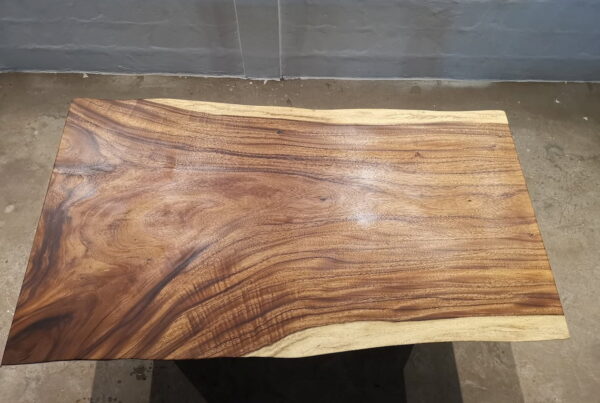It’s no accident that raw wood is used in a variety of live edge dining tables created with love and care by both expert carpenters and do-it-yourself enthusiasts of all ages. This highly prized material must be subjected to specific treatments that must be carried out on a regular basis, both in the case of creating products for internal use and in the case of creating products designed to be used outdoors, in order to maintain its functional and aesthetic properties over time.
We will examine how to handle raw wood when maintaining single slab live edge dining tables in order to help all DIY enthusiasts.
Natural safeguards for dining tables with live edges
Particularly when used to make outdoor objects, wood is constantly subjected to the aggressive action of numerous combined forces, including UV rays and air agents, which over time may severely damage it.
The factors to take into account when designing an exotic wood table
What steps should you take to protect the live edge dining tables?
Applying natural oil, more specifically linseed oil, to the surface of raw wood is one option that is currently underappreciated when working with it, especially in terms of treatment and finishing.
Since the beginning of time, linseed oil has been appreciated for its capacity to penetrate and occupy the fibers of unfinished wood.
To prevent dirt buildup and potential contact with liquids, a real protective screen is actually constructed on the live edge dining tables, enhancing the material’s resistance.
Linseed oil is applied to live edge dining tables to protect them from the damaging effects of UV radiation and air pollution.
Applying linseed oil on wood
Now let’s examine how to treat wood with linseed oil. Utilizing pure, 100 percent linseed oil is the finest choice. Once you have the product, applying it on wooden surfaces is an easy process.
Simply use a brush with soft bristles to apply the oil evenly and in the direction of the wood’s grain.
On the other hand, a cotton towel can be used to wipe away any extra oil from the top layer. The product needs to be reapplied after twenty-four hours, but this time with a different hand.
An great “green” choice for safeguarding wood is linseed oil. However, there are several solutions on the market that are quite effective at enhancing the natural beauty and longevity of timber materials.
When working with unfinished wood that will be exposed to the outdoors, more caution should be taken. Take into account the wood that is utilized in garden floors, fences, benches, and gazebos.
Now, let’s examine the process for preparing live edge dining tables for outdoor use.
Outdoor wood is constantly at risk from water, UV radiation, humidity, wind, ice, and snow. A slew of elements that consistently put its integrity and appeal in danger.
When used outside, live edge dining tables gradually lose their color, becoming opaque, and become less resilient to the numerous stresses they encounter every day. Focused efforts must be made, including the use of products created especially to preserve the qualities of wood materials, to prevent the recurrence of such problems.
How then do live edge dining tables get ready for use outside?
The first line of defense in making sure that the wood is adequately protected when a table is meant to be used outside is the application of an impregnating product.
The impregnating agent is a substance that acts evenly and pro-actively not only on the wood’s surface but also on its fibers on the interior.
By using this technique, the wood can be completely shielded from the numerous harmful factors to which it is subjected during its outdoor life.
How to apply the impregnating substance to wood
Using the impregnating agent requires first thoroughly cleaning the product. You can start applying the first layer after the cleaning is finished. The substance must be applied uniformly and in the direction of the wood grain in this situation as well.
To increase the effectiveness and longevity of the impregnating agent’s action, it is advised to apply two or more coats of the product.
In addition to the impregnating chemical, live edge dining tables intended for outdoor use also receive other specific treatments, such as outdoor lubricants. Such substances may offer the wood’s surface layer a nourishing layer of defense.
LTJarbor proposal
For every table, we provide a selection of finishes, ranging from matte/natural to mirror-image shine. Finding the ideal finish for your area is simple.
You can order dining tables made of acacia wood or golden acacia slabs (Monkey Pod Wood, Chamcha Wood). Sizes range from 20 inches to 60 inches in width, 70 inches to 33 feet in length, and three (3) inches in thickness.
In our method, the slab is flattened before being sanded with various grit grades and finished with polyurethane or Rubio hard. Only one week is needed for processing.




![The many uses and benefits of resin tables [part 2]-22](https://ltjarbor.com/wp-content/uploads/2022/01/The-many-uses-and-benefits-of-resin-tables-part-2-22-e1642739105272-600x403.jpg)

